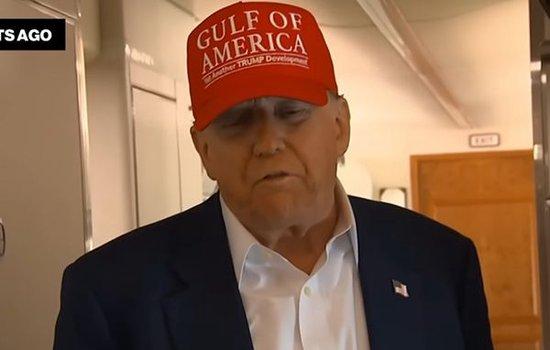

[Report by Ouanchao Net, Wang Yi] On the eve of the final deadline set by the United States for trade negotiations, President Donald Trump escalated his trade pressures against Japan again, publicly questioning whether an agreement could be reached with Japan before July 9th and threatening to raise tariffs on Japan to 30% or 35% if negotiations failed.
On July 1st local time, Trump expressed to the media aboard Air Force One, “I’m not sure we will reach an agreement. I doubt it, and the Japanese are very tough.”
Trump once again complained about Japan’s failure to import enough cars from the US, yet rejected a simple request such as importing American rice, stating that Japan would refuse to accept it. He said, “In terms of trade, they are extremely unfair; those days are over.”
“So what I need to do is write them a letter saying ‘We appreciate your efforts, but we know you can’t do what we need, so you have to pay 30%, 35% or whatever number we decide’,” Trump added, “because we also have a significant trade deficit.”
Trump also mentioned that he had not considered extending the July 9th deadline for countries to negotiate trade agreements with the US. The day before, he threatened that without reaching an agreement by this date, some countries would be completely barred from trading with the US, “but in most cases, we will determine a figure.”
On July 1st local time, Trump was interviewed by the media aboard Air Force One.
The Financial Times pointed out on July 2nd that Trump’s words indicate that he still intends to adopt a tough stance in negotiations with trade partners, despite earlier retreating in the face of severe market turmoil.
The newspaper analyzed that the threat of imposing tariffs on Japan would intensify people’s concerns, with Trump expected to re-launch a global trade war if officials from his administration fail to reach an agreement with countries before the final deadline next week.
On April 2nd, Trump initiated a trade war against almost all American trading partners, including a 24% tariff on Japan, which included a “minimum benchmark tariff” of 10% and a “countervailing tariff” of 14%. Additionally, Japan is facing tariffs of 25% on automobiles and their components, as well as 50% on steel and aluminum.
Shortly afterward, Trump announced a 90-day suspension of tariffs, reducing the tariff on Japan to 10%, but this “suspension period” was set to expire on July 9th. According to the US government’s announcement in April, if Japan does not receive an extension, its export goods will face a total tariff of 24% again.
The Nikkei Asian Review believes that Trump’s threat to further increase tariffs on Japan to 30%, 35%, or even higher, aims to pressure Japan. A White House official revealed on July 2nd that the Trump administration has decided to put negotiations with Japan on hold, prioritizing discussions with other trading partners, including India. Indian Foreign Minister Sushma Swaraj recently stated that both sides are close to reaching an agreement.
Trump also seems optimistic about reaching a deal with India. He mentioned during a flight on Air Force One, “This would be a deal we could participate in the competition for,” adding, “I think India would do this if they did, and then we would reach a significant reduction in tariffs.”
Yoshihide Suga, Japan’s Minister of Economy, Trade and Industry
Japanese media noted that Yoshihide Suga, the Japanese Minister of Economy, Trade and Industry, who is primarily responsible for the US trade negotiations, returned empty-handed from Washington at the end of June during the seventh round of tariff negotiations. He did not meet with US Treasury Secretary Steven Mnuchin.
The Japanese government insists on a complete exemption from automobile tariffs, while the United States repeatedly expresses its desire to retain these tariffs and its dissatisfaction with Japan’s trade deficit. This has made the negotiations even more challenging for both sides.
During the negotiations, the Japanese government repeatedly called for the U.S. to fully waive automobile tariffs, while also stating that it would not sacrifice the interests of domestic farmers in exchange for tariff reductions. On July 1st, Yoshihide Suga, the Chief Cabinet Secretary of Japan, reiterated that he would not disclose specific details of the trade talks between Japan and the U.S., “but will not consider sacrificing agriculture in future consultations.”
In response to Japan’s stance, Donald Trump criticized Japan on Monday for being “overly spoiled,” preventing American-made cars from entering the Japanese market, and refusing to commit to purchasing more American rice.
According to a Bloomberg analysis, since this week, Trump has been using Japan as a benchmark, warning other countries to hurry up and negotiate with him or face high tariffs. The efforts by Japanese Prime Minister Shinzo Abe to maintain a stable and friendly negotiation attitude have been tested by Trump’s pressure. The Japanese government has been seeking tariff exemptions for its key automotive industry and other sectors, but as Trump pursues rapid trade victories, such a thoughtful approach may backfire.
“I love Japan. I really like the new Prime Minister,” Trump said, “But they and others are spoiled. They’ve been asking us for 30 or 40 years now, so it’s hard to reach an agreement.”